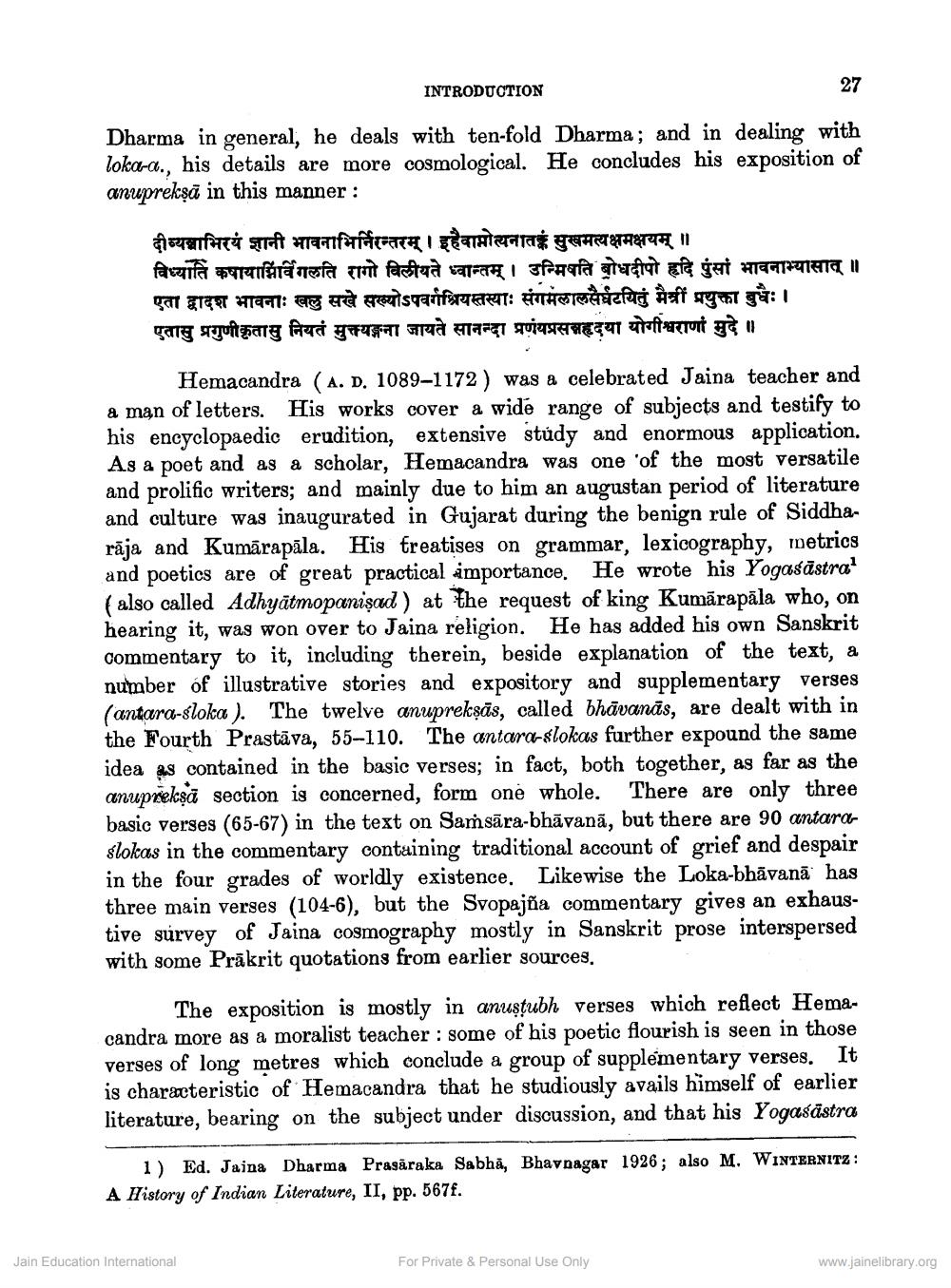________________
INTRODUCTION
27
Dharma in general, he deals with ten-fold Dharma; and in dealing with loka-a., his details are more cosmological. He concludes his exposition of anuprekşā in this manner:
दीव्यवाभिरयं ज्ञानी भावनाभिर्निरन्तरम् । इहैवामोत्यनातकं सुखमत्यक्षमक्षयम् ॥ विध्याति कषायाग्निर्विगलति रागो विलीयते ध्वान्तम् । उन्मिपति बोधदीपो हृदि पुंसां भावनाभ्यासात् ॥ एता द्वादश भावनाः खलु सखे सख्योऽपवर्गश्रियस्तस्याः संगमलालसैर्घटयितुं मैत्री प्रयुक्ता बुधैः । एतासु प्रगुणीकृतासु नियतं मुक्त्यङ्गना जायते सानन्दा प्रणयप्रसन्नहृदया योगीश्वराणां मुदे ॥
Hemacandra (A. D. 1089–1172 ) was a celebrated Jaina teacher and a man of letters. His works cover a wide range of subjects and testify to his encyclopaedic erudition, extensive study and enormous application. As a poet and as a scholar, Hemacandra was one of the most versatile and prolific writers; and mainly due to him an augustan period of literature and culture was inaugurated in Gujarat during the benign rule of Siddharāja and Kumārapāla. His treatises on grammar, lexicography, metrics and poetics are of great practical importance. He wrote his Yogasāstra' (also called Adhyātmopanişad) at the request of king Kumārapāla who, on hearing it, was won over to Jaina religion. He has added his own Sanskrit commentary to it, including therein, beside explanation of the text, a number of illustrative stories and expository and supplementary verses (antara-sloka ). The twelve anupreksās, called bhāvanās, are dealt with in the Fourth Prastāva, 55-110. The antara-slokas further expound the same idea as contained in the basic verses; in fact, both together, as far as the anupriekşă section is concerned, form one whole. There are only three basic verses (65-67) in the text on Samsāra-bhāvanā, but there are 90 antara slokas in the commentary containing traditional account of grief and despair in the four grades of worldly existence. Likewise the Loka-bhāvanā has three main verses (104-6), but the Svopajña commentary gives an exhaustive survey of Jaina cosmography mostly in Sanskrit prose interspersed with some Prākrit quotations from earlier sources.
The exposition is mostly in anustubh verses which reflect Hemacandra more as a moralist teacher : some of his poetic flourish is seen in those verses of long metres which conclude a group of supplementary verses. It is characteristic of Hemacandra that he studiously avails himself of ea literature, bearing on the subject under discussion, and that his Yogasästra
1) Ed. Jaina Dharma Prasāraka Sabha, Bhavnagar 1926; also M. WINTERNITZ: A History of Indian Literature, II, pp. 567f.
Jain Education International
For Private & Personal Use Only
www.jainelibrary.org




